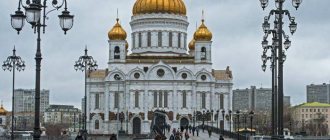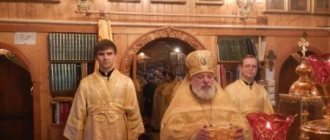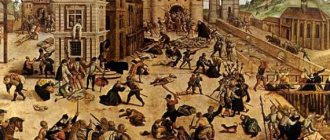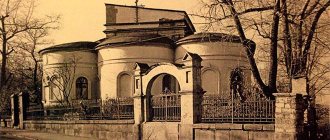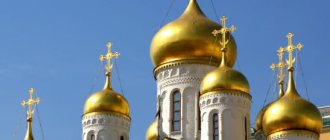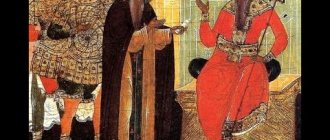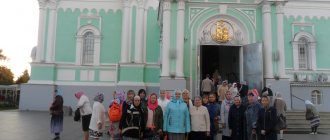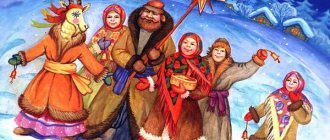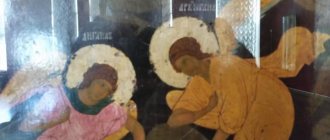ROMAN CATHOLIC CHURCH (RCC; lat. Ecclesia Catholica Romana), the largest Christian Church in terms of the number of believers, uniting followers of Catholicism. According to its name, the Universal (Catholic, Greek: ϰαθολιϰή) Church centered in Rome. Its head (primate) is the Pope. From the point of view of Orthodox ecclesiology until mid. 11th century Rome. church, under the jurisdiction of which were the Christians of Western Europe. Europe, was one of the local churches and was part of the Universal Church; as a result of the Great Schism of 1054 (see Division of Churches) Rom. The church fell away from Ecumenical Orthodoxy, and from that time on it was commonly called the Roman Catholic. church.
Origin
The history of the Roman Catholic Church begins in 1054, when an event occurred that remained in the chronicles under the name “Great Schism.” Although Catholics do not deny that all the events before the schism are their history. They just went their own way from that moment on. In this year, the Patriarch and the Pope exchanged threatening messages and anathematized each other. After this, Christianity finally split and two movements formed - Orthodoxy and Catholicism.
As a result of the split in the Christian Church, a western (Catholic) direction emerged, the center of which was Rome, and an eastern (Orthodox) direction, with its center in Constantinople. Of course, the apparent reason for this event was disagreements in dogmatic and canonical issues, as well as in liturgical and disciplinary issues, which began long before the specified date. And this year, disagreement and misunderstanding reached its peak.
However, in fact, everything was much deeper, and it concerned not only differences in dogmas and canons, but also the usual confrontation between rulers (even church ones) over recently baptized lands. Also, the confrontation was greatly influenced by the unequal position of the Pope and the Patriarch of Constantinople, because as a result of the division of the Roman Empire, it was split into two parts - Eastern and Western.
The eastern part retained its independence for much longer, so the Patriarch, although controlled by the emperor, had protection in the form of the state. The Western one ceased to exist already in the 5th century, and the Pope received relative independence, but also the possibility of attack by barbarian states that appeared on the territory of the former Western Roman Empire. Only in the middle of the 8th century were lands given to the Pope, which automatically made him a secular sovereign.
Story
Tomb of the Apostle Peter. Vatican.
Rome. Christian community was founded by ap. Peter, who, according to legend, led it before his martyrdom. death. During the 2nd century. Christianity, despite periodic persecution spread throughout the territory of Rome. empire and, according to the Edict of Milan (313), received official status. recognition by the authorities. The free profession of Christianity led to the flourishing of theology, which found expression in the works of the fathers and teachers of the Church and in the decisions of the doctrine of faith. questions at the Ecumenical Councils. The RCC recognizes as Ecumenical 8 councils held in the 1st millennium (Ecumenical Orthodoxy recognizes the first 7 of them), and another 13 councils held in the 2nd millennium. 1st thousand in Rome. Monasticism appeared in the church. After liquidation in 476 Zap. Rome. Empire 2nd half. 1st thousand passed for Rome. Church in the works on the evangelization of the peoples of the new states that arose in the West., Center. and Sev. Europe. All R. 8th century Thanks to the support of the Frankish king Pepin the Short, a sovereign state arose - the Papal States, which ensured the ministry of the pope, independent of the secular authorities.
Gradually in Christianity in Lat. West and Greek east of Rome Empire, in addition to the differences in languages and cultures, were added the accumulating features in theology, worship, canon, and church system, which led in 1054 to the rupture of Rome. churches from the east Christianity. 11th century marked for Rome. The church will end with the beginning of the Gregorian reform, associated with the activities of Pope Gregory VII and aimed at strengthening discipline in the Church in the form of the fight against simony. establishment of celibacy lat. clergy and the struggle for investiture. In the 11th–13th centuries. The RCC inspired the crusades to return the lands of the Middle East conquered by the Arabs from their many. Christian shrines. 13th century became the heyday of scholasticism (St. Albert the Great, St. Bonaventure, St. Thomas Aquinas, etc.), Gothic. architecture (see Gothic), the emergence of new monastic orders (Franciscans, Dominicans, etc.) and tertiaries, harmony in the relations of secular and spiritual authorities (French King Louis IX Saint, etc.). However, from the beginning. 14th century Another confrontation between the papacy and secular power began, ending first with the Avignon Captivity of the Popes (1309–1377), and then with the Great Schism (1378–1417), when several existed simultaneously. dad. The schism that was overcome at the Council of Constance (1414–18) made itself felt for some time in the form of the Council Movement - the doctrine of the superiority of the Ecumenical Council over the pope.
The flourishing of Renaissance culture at the end. 15 – beginning 16th centuries gave the RCC not only great masters who created Catholic masterpieces. art (Raphael, Leonardo da Vinci, Michelangelo), but also contributed to the emergence of tendencies towards secularization of church life, which led to a protest reaction in the form of the Reformation and the emergence of Protestantism. The reaction to this schism was Catholicism. The Counter-Reformation, defined by the Council of Trent (1545–63), which clarified the meaning. number of provisions catholic. religious doctrines and outlined strict disciplinary measures. The fruits of the Counter-Reformation for the RCC in the end. 16th – 17th centuries steel like internal the strengthening of Catholicism means just that. success in missionary endeavors aimed at converting the peoples of America. continent and accession through the policy of union (see Uniatism) eastern. Christians (for example, Union of Brest 1596).
Creation of absolute monarchies in the West. Europe came to a standstill. 17th – 18th centuries to a new increase in tension between the Papal Throne and secular authorities (Gallicanism, Josephism), and the beginning of the Enlightenment era further aggravated the position of the RCC. French Revolution 18th century. led to massive repressions against the RCC, comparable to the persecutions in Rome. empires. As a result of the Napoleonic wars, the Papal State was abolished. Its revival after the victory over Napoleon I turned out to be short-lived, and in 1870 it was finally liquidated during the Risorgimento (as a result of the Lateran Agreements of 1929, the Vatican State was created; see also “The Roman Question”).
In con. 19 – beginning 20th centuries The RCC was forced to confront not only external problems with secular authorities (for example, the separation of Church and state in France), but also to respond to attempts to question the principle of papal authority and tradition. fundamentals of doctrine and the right of the Church to claim the role of mentor to broad sections of the population. These responses included the adoption of the dogma of papal infallibility at Vatican Council I in 1870, Pope Leo XIII's development of Christian social teaching (encyclical Rerum novarum, 1891), and the anti-modernist documents of Popes Pius IX (Syllabus, 1864) and Pius X (decree “Lamentabili”, 1907; encyclical “Pascendi Dominici gregis”, 1907).
As a result of Vatican II Council (1962–65), a radical renewal of all aspects of church life was carried out in the RCC, affecting the sacramental and doctrinal components, which caused resistance from conservative circles of the RCC (Lefebvrists, Sedevacantists).
Modern spread of Catholicism
Today, Catholicism is the most numerous branch of Christianity, which is spread throughout the world. As of 2007, there were about 1.147 billion Catholics on our planet. The largest number of them is located in Europe, where in many countries this religion is the state religion or predominates over others (France, Spain, Italy, Belgium, Austria, Portugal, Slovakia, Slovenia, Czech Republic, Poland, etc.).
On the American continent, Catholics are spread everywhere. Also, followers of this religion can be found on the Asian continent - in the Philippines, East Timor, China, South Korea, and Vietnam. There are also many Catholics in Muslim countries, but most of them live in Lebanon. They are also common on the African continent (from 110 to 175 million).
Orthodoxy and Catholicism
The church calendar is divided: the Orthodox Church celebrates holidays and days of remembrance of saints according to the old style (Julian calendar), the Catholic Church - according to the Gregorian calendar (this is due to astronomical phenomena).
Regarding the Nativity of Christ, the Gregorian calendar is more convenient: after all, the week of holidays begins on December 24-25 with Christmas and continues with the New Year, but Orthodox Christians must celebrate the New Year modestly and calmly in order to observe fasting. However, an Orthodox person can also have fun on New Year's Eve, trying not to eat meat or any particularly tasty things (if he is visiting). Likewise, children in Orthodox families should not be deprived of the New Year holiday and the joy of Santa Claus. It’s just that many Orthodox families try to emphasize the significance of Christmas with more expensive gifts, more active joint visits to events, etc.
Let us note that Christmas is celebrated on December 25 by a number of Orthodox Local Churches, but all Orthodox Christians celebrate Easter on the same day (this holiday shifts depending on the phases of the moon). The fact is that only on Orthodox Easter does the descent of the Holy Fire take place in Jerusalem.
This is truly a miracle that people expect every year with faith and hope. Its meaning is the self-ignition of the lamp on the Holy Sepulcher in the presence of the Patriarch of Constantinople. They prepare for the Holy Saturday service in advance, but no one knows at what hour the Holy Fire will descend. According to legend, one year he will not appear, and this will mean the onset of the end times, the End of the World.
Every year, on Saturday morning, the Ecumenical Patriarch with a retinue of clergy enters the Church of the Resurrection of Christ and undresses himself down to his white cassock in its center, at the Chapel of the Holy Sepulcher (Edicule), which stands above the very place where Christ was resurrected, above the Stone of His Sepulchre. All light sources in the temple are extinguished - from lamps to chandeliers. The Patriarch, according to the tradition that emerged after the Turkish rule in Jerusalem, is searched for the presence of anything that would contribute to the ignition of the Fire. The sacristan brings into the Edicule cave a lamp, which is placed in the middle of the Holy Sepulcher, and the same torch of 33 Jerusalem candles. As soon as the Orthodox Patriarch enters there, accompanied by the Primate of the Armenian Church, the cave with them is sealed with wax. Pilgrims fill the entire temple - the words of prayers are heard here, the confession of sins takes place in anticipation of the descent of the Fire. Typically this wait lasts from several minutes to several hours. As soon as flashes of lightning appear above Edicule, signifying the Convergence, a bell rings above the temple. Many millions of people over the centuries have witnessed this miracle, because even today scientists cannot explain with anything other than God’s power the flashes of lightning in the temple on Holy Saturday.
The patriarchs pass Jerusalem candles into the chapel window, and pilgrims and priests in the temple begin to light their torches from them. Again, from a few minutes to an hour the Holy Fire does not burn and pilgrims scoop it up with their hands and wash their faces. Fire does not ignite hair, eyebrows, or beards. All of Jerusalem is ablaze with thousands of candle torches. By air, representatives of Local Churches transport the Holy Fire in special lamps to all countries. They are revered by both Catholics and Orthodox Christians.
Subsequently, traders burn pre-prepared torches in the Holy Fire, extinguish them and sell them all over the world as Jerusalem candles. It is necessary to store them carefully, like a shrine. You can light Jerusalem candles in front of any icon during any prayer. However, you can light a simple church candle this way, meanwhile Jerusalem candles are placed
- During the celebration of Easter (within 40 days before Easter);
- During difficulties, serious illnesses, in sadness, when special prayer is required.
Internal management structure of the church
Now we should consider what the administrative structure of this direction of Christianity is. The Pope of the Roman Catholic Church is the highest authority in the hierarchy and has jurisdiction over the laity and clergy. The head of the Roman Catholic Church is elected at a conclave by the College of Cardinals. He usually retains his powers until the end of his life, except in cases of legal self-denial. It should be noted that in Catholic teaching, the Pope is considered the successor of the Apostle Peter (and, according to legend, Jesus ordered him to take care of the entire church), therefore his power and decisions are infallible and true.
Further in the structure of the church there are the following positions:
- Bishop, priest, deacon - degrees of priesthood.
- Cardinal, Archbishop, Primate, Metropolitan, etc. – church degrees and positions (there are many more of them).
The territorial units in Catholicism are as follows:
- Individual churches called dioceses or dioceses. The bishop is in charge here.
- Special dioceses of importance are called archdioceses. They are headed by an archbishop.
- Those churches that do not have diocese status (for one reason or another) are called apostolic administrations.
- Several dioceses united together are called metropolitanates. Their center is the diocese whose bishop has the rank of metropolitan.
- Parishes are the foundation of every church. They are formed within a particular area (for example, a small town) or due to a common nationality or linguistic differences.
Existing rituals of the church
It should be noted that the Roman Catholic Church has differences in rituals during worship (however, unity in faith and morals is maintained). The following popular rituals exist:
- Latin;
- Lyon;
- Ambrosian;
- Mozarabic, etc.
Their difference may be in some disciplinary issues, in the language in which the service is read, etc.
Monastic orders within the church
Due to the broad interpretation of church canons and divine dogmas, the Roman Catholic Church has about one hundred and forty monastic orders in its composition. They trace their history back to ancient times. We list the most famous orders:
- Augustinians. Its history begins approximately in the 5th century with the writing of the charter by St. Augustine. The direct formation of the order occurred much later.
- Benedictines. It is considered the first officially founded monastic order. This event occurred at the beginning of the 6th century.
- Hospitallers. A knightly order founded in 1080 by the Benedictine monk Gerard. The religious charter of the order appeared only in 1099.
- Dominicans. A mendicant order founded by Dominic de Guzman in 1215. The purpose of its creation is to combat heretical teachings.
- Jesuits. This direction was created in 1540 by Pope Paul III. His goal became prosaic: the fight against the growing movement of Protestantism.
- Capuchins. This order was founded in Italy in 1529. His original goal is still the same - the fight against the Reformation.
- Carthusians. The first monastery of the order was built in 1084, but it itself was officially approved only in 1176.
- Templars. The military monastic order is perhaps the most famous and shrouded in mysticism. Some time after its creation, it became more military than monastic. The original purpose was to protect pilgrims and Christians from Muslims in Jerusalem.
- Teutons. Another military monastic order that was founded by the German crusaders in 1128.
- Franciscans. The order was created in 1207-1209, but approved only in 1223.
In addition to the orders, in the Catholic Church there are the so-called Uniates - those believers who have retained their traditional worship, but at the same time accepted the teachings of the Catholics, as well as the authority of the Pope. This may include:
- Armenian Catholics;
- Redemptorists;
- Belarusian Greek Catholic Church;
- Romanian Greek Catholic Church;
- Russian Orthodox Catholic Church;
- Ukrainian Greek Catholic Church.
The difference between the Catholic Church and the Orthodox Church
Now about how the Russian Orthodox Church and the Roman Catholic Church differ from each other in the modern version:
- For the Orthodox, the unity of the church is faith and sacraments, and for Catholics this includes the infallibility and inviolability of the authority of the Pope.
- For Orthodox Christians, the Ecumenical Church is each local church, which is headed by a bishop. For Catholics, communion with the Roman Catholic Church is mandatory.
- For Orthodox Christians, the Holy Spirit comes only from the father. For Catholics, it is from both the Father and the Son.
- In Orthodoxy, divorce is possible. They are unacceptable among Catholics.
- In Orthodoxy there is no such thing as purgatory. This dogma was proclaimed by Catholics.
- The Orthodox recognize the holiness of the Virgin Mary, but deny her immaculate conception. Catholics have a dogma that the Virgin Mary was born in the same way as Jesus.
- The Orthodox have one ritual that originated in Byzantium. There are many of them in Catholicism.
What is the difference between a church and a temple: a brief comparison
The church is God's house. A home for chosen people, for the chosen. Therefore, a church is not a building, but a group of people who believe in God. A temple is also a church. The most important part of the temple is the altar. On the altar there is a meal with a throne (the room in which the person praying is located). The sacraments of communion and bloodless sacrifice are performed on the throne.
The difference between a church and a temple
So, let's list the main differences between a temple and a church:
- The term "church" is a broad concept that refers to an architectural structure, plus a collection of several people.
- The term "temple" is a special place where worship is held.
- A Christian temple consists of an altar and an altar.
- Any church is a Christian temple.
- The main city church is called the cathedral.
